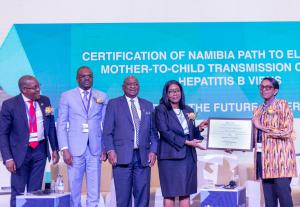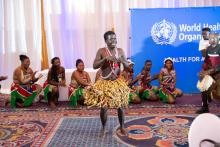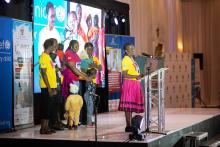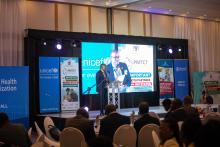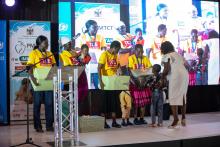WHO awards Namibia for milestone achievement towards path to elimination of vertical mother-to-child transmission of both HIV and viral hepatitis B
The government of Namibia hosted a high-level event to commemorate the global award received from the World Health Organization (WHO) for achieving the Silver Tier on the Path-To-Elimination (PTE) of The government of Namibia hosted a high-level event to commemorate the global award received from the World Health Organization (WHO) for achieving the Silver Tier on the Path-To-Elimination (PTE) of mother-to-child transmission (MTCT) of Hepatitis B Virus (HBV), and the Bronze Tier on the PTE of mother-to-child transmission of HIV. Namibia became the first country in Africa and the first high-burden country in the world to reach a significant milestone on the path towards eliminating vertical mother-to-child transmission of both HIV and viral hepatitis B.
“As a woman living with HIV for 28 years who lost 2 children to AIDS-related illnesses, in their infancy in the early years of the HIV pandemic, I would not have imagined that I would witness this achievement today”, noted Victoria Kamule, the Executive Director of an organization of People Living with HIV (PLHIV) Network called TONATA which means “open the eyes of your heart”. Ms Kamule is also the chairperson of the Namibia Networks of AIDS Service Organizations (NANASO).
Congratulating Namibia on the certification the WHO Director General Dr Tedros Adhanom Ghebreyesus commended the Government of Namibia, Health Care Workers and civil society organizations for impressive progress in the prevention of mother-to-child transmission. Dr Tedros added that Namibia is the first country to have applied for triple elimination of HIV, Syphilis and Hepatitis B. “Namibia is a pathfinder country around the world to follow” commented the Director General.
This remarkable global award is an outcome of strong leadership that led to a well-coordinated response, the country is one of the first high-burden countries to approach epidemic control estimated to be at 95-97-94 as defined by the UNAIDS 95-95-95 treatment cascade. New HIV infections have halved since 2004, and life expectancy increased by seven years, from 56 in 2005 to 63 in 2019. Despite the high prevalence of HIV amongst women of reproductive age, in 2022, the country attained a coverage of over 95% for the first antenatal care visit at 97%, pregnant women HIV and syphilis testing, and maternal antiretroviral therapy. Annually in Namibia, around 12,000 infants are born to mothers living with HIV and reaching an MTCT rate of 4.4% is applaudable.
Vaccination is an integral part of primary health care and child health. 2014 marked milestone achievements in the country with the introductions of the Hepatitis B birth dose vaccine, yearly vaccine microplanning as well as the African Vaccination and Maternal and Child Health weeks. These contributed significantly to improved immunization rates including the Hepatitis B birth dose and third dose. Namibia reached immunization coverage of 83% for viral hepatitis B birth dose administered within 24hrs and a 3rd dose coverage of 94% in 2021. The birth dose coverage increased to 92% in 2023.
WHO Regional Director for Africa, Dr. Matshidiso Moeti highlighted that Namibia’s certification on the PTE was a result of rigorous assessments of four thematic areas data quality, strong programmes, laboratory quality, human rights, gender equity, and community engagement. She further indicated that WHO is continuing to support the facilitation of Namibia’s progression to the gold tier for Hepatitis B and HIV, as well as towards the targets for syphilis. Namibia introduced the prevention of the MTCT program in 2002, lifelong antiretroviral therapy (ART) for pregnant women (option B-plus) in 2013 and lifelong treatment for all irrespective of CD4 count in 2016.
Speaking on behalf of the Joint United Nations Team on AIDS (JUTA), Dr. David Chipanta, UNAIDS Country Director in Namibia indicated that Namibia’s achievement underscores the resolute political commitment demonstrated by the government of Namibia towards investments in healthcare. He further added that the progress witnessed demonstrates that an HIV-free generation is indeed within reach.
Namibia’s path to triple elimination launched several key policies that made this success possible:
• National Roadmap for Path to Elimination of Mother-to-Child Transmission of HIV and Syphilis 2020-2024.
• Inclusion of Hepatitis B in its elimination initiatives aligning to the 2022 WHO guidance for triple elimination
• Establishment of a multi-sectoral National Validation Committee (NVC)
These concerted efforts had a positive impact on the overall rates of mother-to-child transmission of HIV reducing from 13.72% in 2010 to 4.14% in 2022.
The award was received by Namibia’s Prime Minister, Right Honorable Dr. Saara Kuugongelwa- Amadhila. In his remarks at the award handover, Honorable Dr. Kalumbi Shangula, Minister of Health and Social Services stated that the goal of the PMTCT programme is to eliminate mother-to-child transmission of HIV with a target to achieve a rate of less than 2% by 2028. “This goal is to be achieved through the implementation of interventions that address all pillars of PMTCT. We are encouraged that Namibia’s investment in health, particularly in the prevention of mother-to-child transmission of infectious diseases such as HIV and Hepatitis B is paying off, is bearing fruits” he added. Namibia’s PTE journey and the certification is premised on strong multilateral and bilateral partnerships including with PEPFAR, US Government CDC and PEPFAR implementing partners, the Global Fund, UN agencies such as WHO, UNAIDS, UNFPA and UNICEF, Global Fund, Civil Society Organizations and many other committed partners.
To celebrate this achievement the MoHSS with the support of partners hosted a special dinner attended by close to 400 delegates to celebrate the global award. The delegates included the Hon. Minister of Health as the host, WHO AFRO Regional Director, H.E United States of America Ambassador to Namibia, ministers and their assistants of other African states who were attending the Africa Health Workforce Investment Forum, partners including CDC, UN Agencies and Civil Society Organizations including NANASO.
Beneficiaries of PMTCT services celebrated their babies who were born HIV-negative because of the PMTCT program and acknowledged the Government and partners for the program. The MoHSS awarded regions that performed well in the PTE initiatives with roving trophies to Omusati, Erongo, Omaheke and Kavango West regions.



